jmveverka
Well-known member
I thought I would share a story I wrote about my Thanksgiving Buffalo hunt at Fort Peck. Had a great time and while not difficult, I do feel that it was an actual hunt - albeit guided hunt.
https://www.huntingwire.com/features/ebfab4eb-89ac-4171-94da-c35fa1ab903f
After learning about this program several years ago, I began applying to hunt with Fort Peck. This summer, I learned that I drew a tag to hunt a bull bison on the Fort Peck Reservation. I was thrilled to harvest a buffalo, but immediately, I had the same thoughts many reading this have: Is this a real hunt?
Yes, it is. Was it a hard hunt like DIY Elk? No, but very few hunts are. I would equate the effort to that of an antelope hunt, with some caveats. Finding buffalo on the prairie was easy—they are big black bodies on an open pasture. Getting in range was a little more complicated, but not really difficult—they are wild animals, and after months of being hunted, they were skittish, but there are also not many things in nature that threaten a buffalo. That being said, we did blow one stalk, could not get in range on another, and finally closed the deal on the third and, ultimately, fourth stalks. The hardest parts? Harsh conditions and putting the animal on the ground. This tough critter lives on an incredible and, at times, harsh landscape.
When scheduling the hunt, I knew I wanted to hunt later in the season to ensure the hide was as thick and fluffy as possible. I also had to make it work within my work and kids' school schedules since this would be a family trip. The Friday after Thanksgiving was the natural date that made the most sense. Luckily, the date was available (they only like to take out one hunter per day), and I could find an Airbnb so we could still cook Thanksgiving dinner!
As the hunt day arrived, the temperature in Wolf Point, Montana, hovered right around 1 degree, with wind chills hitting negative double digits. My son (we arranged with Fort Peck to allow him to harvest a cow buffalo as my companion) and I met the program leader and headed towards the pasture before sunrise. My tag called for a 4-5-year-old "management" bull bison. Our target for the morning was a group of bulls who were making trouble for the staff as they kept getting out of their enclosure by jumping or breaking fences.
It took little time to reach the northern end of the 13,000-acre pasture. This breathtaking landscape truly represented the Montana "big sky" moniker. We quickly located the bulls, who were, in fact, outside the pasture in a neighboring canola field. We made our initial approach from a coulee and got ahead of the bachelor group. As we set up for the shot, we could only see their humps above the hill, but they soon approached, and I had my first buffalo line up in the crosshairs. With an animal as tough as a buffalo, a close, broadside shot is necessary, and much like any hunting, we need to isolate a single bull so as not to hit the wrong animal. This proved problematic in the herd, and while they gave me multiple looks, I could never isolate a bull with a broadside shot. Soon, they spooked, and it was time for a reset. A quick truck ride across several fields, and we began approaching on foot again. Unfortunately, we ran out of topography to cover our approach at around 400 yards and had no way to get closer without risking the bulls spooking to an area we could not get to. We backed out and strategized a new approach. The bulls continued to move along the outside of their pasture, and we were finally able to get ahead of them and get set up. I focused on the two bulls in the front, but they played hide-and-seek behind each other, and I was not comfortable with their position. Finally, the next bull back made the mistake of isolating himself perfectly broadside.
he 200-grain bullet found home in the vitals, and he stood there. Another round found home and he looked to be going down but managed to keep his feet and begin to walk. A third round to the lungs and he finally lost energy and went down. As I approached the downed animal (after using the truck to move the rest of the herd away), only then did I truly appreciate how big these animals are. Picture time ensued and Fort Peck staff members arrived with a trailer to transport the bull for skinning.
My 16-year-old son was next up with his cow tag. The decision to take a second bison was difficult, both from a cost and logistics of meat handling standpoint, but I did not want to pass on this chance to give my best hunting buddy a shot at something truly memorable. Plus, my bull would likely not taste as good as his cow, so we went ahead and sought a new herd. We headed for the south end of the pasture where I had spotted some buffalo the day before. On the top of a plateau stood a group of 30 cows, calves, and young bulls.
This time, our approach was more straightforward as these animals were in break country, and we could drop down behind them and come up out of the coulee in range. It did not take long, and we were set up in a prone position at 150 yards. Then it was a waiting game. We wanted to identify a mature cow with no calf, and she had to be separated from others and standing broadside. The cold temps began to set in on us, but soon, we found our target, and my son made a great shot. The telltale "thump" of a shot in the cavity was quickly followed by the cow going to the ground. But she had different ideas and managed to stand. We were now faced with either getting her down here or looking at a difficult recovery from the breaks if she could escape with the rest of the herd. He made another good shot and, at the guide's urging to get her on the ground, sent a third round to finish her off. Pictures, loading, and a trip to the skinning area remained.
Reflecting back, this trip exceeded my expectations. The cold and snow, the Fort Peck story of conservation, the chance to take my son along, and the great bull I was able to take all added to the adventure and mystique of hunting one of these massive animals on their native ground.
I encourage anyone interested to check out https://fishandgame.fortpecktribes.org/ and learn more about their hunting opportunities. Don't wait long though. The Pope and Young Club has just announced that they are now accepting bison from Fort Peck into their record books, and Fort Peck is also petitioning Boone and Crockett to follow suit. With these organizations officially recognizing the Fort Peck Buffalo program as a fair chase hunt, I expect demand for the hunts to grow.
https://www.huntingwire.com/features/ebfab4eb-89ac-4171-94da-c35fa1ab903f
After learning about this program several years ago, I began applying to hunt with Fort Peck. This summer, I learned that I drew a tag to hunt a bull bison on the Fort Peck Reservation. I was thrilled to harvest a buffalo, but immediately, I had the same thoughts many reading this have: Is this a real hunt?
Yes, it is. Was it a hard hunt like DIY Elk? No, but very few hunts are. I would equate the effort to that of an antelope hunt, with some caveats. Finding buffalo on the prairie was easy—they are big black bodies on an open pasture. Getting in range was a little more complicated, but not really difficult—they are wild animals, and after months of being hunted, they were skittish, but there are also not many things in nature that threaten a buffalo. That being said, we did blow one stalk, could not get in range on another, and finally closed the deal on the third and, ultimately, fourth stalks. The hardest parts? Harsh conditions and putting the animal on the ground. This tough critter lives on an incredible and, at times, harsh landscape.
When scheduling the hunt, I knew I wanted to hunt later in the season to ensure the hide was as thick and fluffy as possible. I also had to make it work within my work and kids' school schedules since this would be a family trip. The Friday after Thanksgiving was the natural date that made the most sense. Luckily, the date was available (they only like to take out one hunter per day), and I could find an Airbnb so we could still cook Thanksgiving dinner!
As the hunt day arrived, the temperature in Wolf Point, Montana, hovered right around 1 degree, with wind chills hitting negative double digits. My son (we arranged with Fort Peck to allow him to harvest a cow buffalo as my companion) and I met the program leader and headed towards the pasture before sunrise. My tag called for a 4-5-year-old "management" bull bison. Our target for the morning was a group of bulls who were making trouble for the staff as they kept getting out of their enclosure by jumping or breaking fences.
It took little time to reach the northern end of the 13,000-acre pasture. This breathtaking landscape truly represented the Montana "big sky" moniker. We quickly located the bulls, who were, in fact, outside the pasture in a neighboring canola field. We made our initial approach from a coulee and got ahead of the bachelor group. As we set up for the shot, we could only see their humps above the hill, but they soon approached, and I had my first buffalo line up in the crosshairs. With an animal as tough as a buffalo, a close, broadside shot is necessary, and much like any hunting, we need to isolate a single bull so as not to hit the wrong animal. This proved problematic in the herd, and while they gave me multiple looks, I could never isolate a bull with a broadside shot. Soon, they spooked, and it was time for a reset. A quick truck ride across several fields, and we began approaching on foot again. Unfortunately, we ran out of topography to cover our approach at around 400 yards and had no way to get closer without risking the bulls spooking to an area we could not get to. We backed out and strategized a new approach. The bulls continued to move along the outside of their pasture, and we were finally able to get ahead of them and get set up. I focused on the two bulls in the front, but they played hide-and-seek behind each other, and I was not comfortable with their position. Finally, the next bull back made the mistake of isolating himself perfectly broadside.
he 200-grain bullet found home in the vitals, and he stood there. Another round found home and he looked to be going down but managed to keep his feet and begin to walk. A third round to the lungs and he finally lost energy and went down. As I approached the downed animal (after using the truck to move the rest of the herd away), only then did I truly appreciate how big these animals are. Picture time ensued and Fort Peck staff members arrived with a trailer to transport the bull for skinning.
My 16-year-old son was next up with his cow tag. The decision to take a second bison was difficult, both from a cost and logistics of meat handling standpoint, but I did not want to pass on this chance to give my best hunting buddy a shot at something truly memorable. Plus, my bull would likely not taste as good as his cow, so we went ahead and sought a new herd. We headed for the south end of the pasture where I had spotted some buffalo the day before. On the top of a plateau stood a group of 30 cows, calves, and young bulls.
This time, our approach was more straightforward as these animals were in break country, and we could drop down behind them and come up out of the coulee in range. It did not take long, and we were set up in a prone position at 150 yards. Then it was a waiting game. We wanted to identify a mature cow with no calf, and she had to be separated from others and standing broadside. The cold temps began to set in on us, but soon, we found our target, and my son made a great shot. The telltale "thump" of a shot in the cavity was quickly followed by the cow going to the ground. But she had different ideas and managed to stand. We were now faced with either getting her down here or looking at a difficult recovery from the breaks if she could escape with the rest of the herd. He made another good shot and, at the guide's urging to get her on the ground, sent a third round to finish her off. Pictures, loading, and a trip to the skinning area remained.
Reflecting back, this trip exceeded my expectations. The cold and snow, the Fort Peck story of conservation, the chance to take my son along, and the great bull I was able to take all added to the adventure and mystique of hunting one of these massive animals on their native ground.
I encourage anyone interested to check out https://fishandgame.fortpecktribes.org/ and learn more about their hunting opportunities. Don't wait long though. The Pope and Young Club has just announced that they are now accepting bison from Fort Peck into their record books, and Fort Peck is also petitioning Boone and Crockett to follow suit. With these organizations officially recognizing the Fort Peck Buffalo program as a fair chase hunt, I expect demand for the hunts to grow.




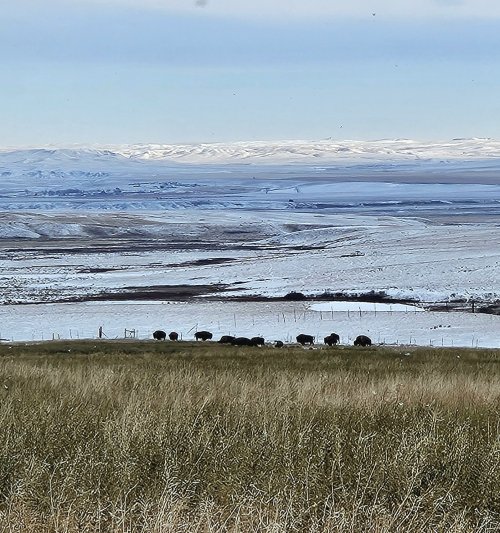
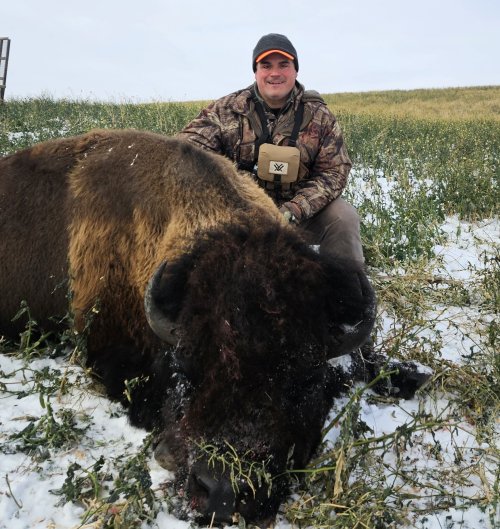
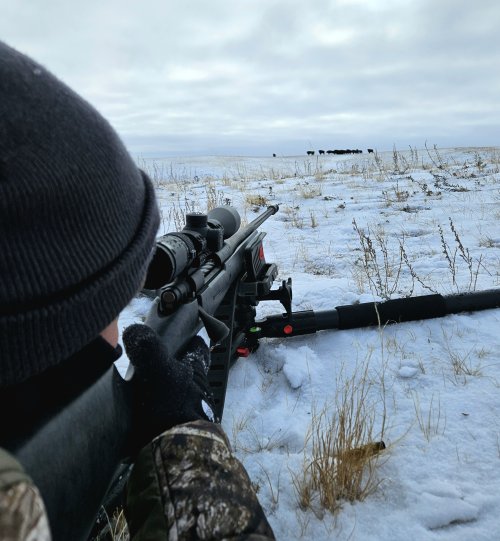
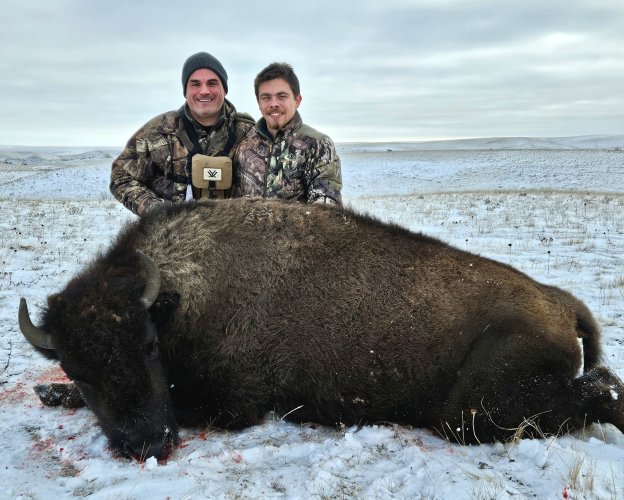
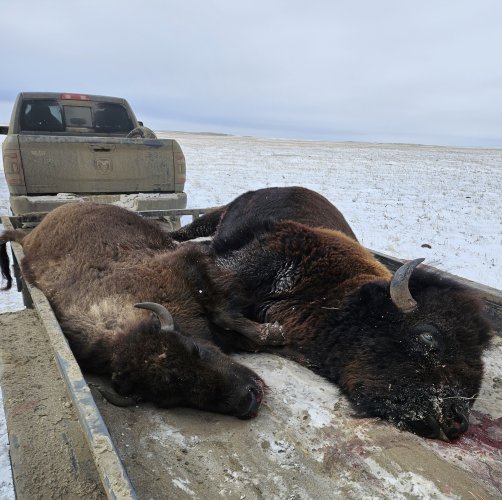
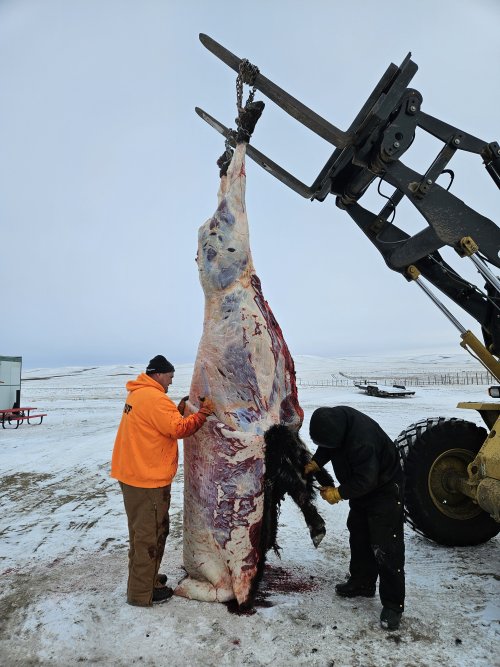
![20250214_093836[2].jpg 20250214_093836[2].jpg](https://www.hunttalk.com/data/attachments/336/336378-2056fb1bb3860f8db50c6b87ce182341.jpg)
